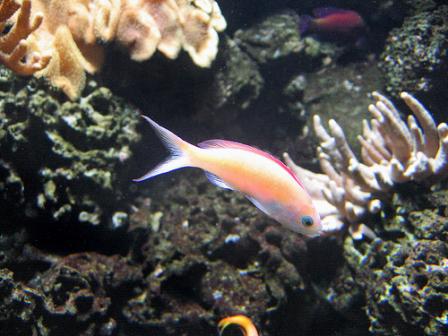Coral reefs are threatened across the world's oceans by seaweed. Scientists and ecologists have found a natural protection mechanism within the biology of the corals themselves. A study posted in the journal of Science has shown that a certain species of coral, Acropora nasuta, releases a chemical signal to attract the gobies species Gobidon histrio and Paragobidon enchinocephalus to the site of attack when threatened by a harmful seaweed.
Researchers Marcus Hay and Danielle Dixson at the Georgia Institute of Technology performed a study in the Fiji islands analyzing what occurred to the coral Acropora nasuta when filaments from the toxic seaweed Chlorodesmis fastigiata were placed near it. They noticed that within seconds, inch-long gobies appeared to move the seaweed away from the coral. Over the course of 3 days, the seaweed mass declined by 30-40%, and the damage to the coral decreased by 70-80%. This did not occur whatsoever in corals that were not occupied by gobies.
“These little fish would come out and mow the seaweed off so it didn’t touch the coral,” said Marcus Hay, professor at the school of Biology at Goeriga Institute of Technology. Further analysis of the gobies' digestive tracts uncovered that the species Gobidon histrio actually consumes the toxic seaweed, which provides an extra benefit for these gobies: they become less attractive to predators. Paragobidon enchinocephalus, on the other hand, simply bites off the seaweed and spits it out. In return for this protective behavior, the gobies feed off the mucus, zooplankton, and algae in the coral environment. The two maintain a healthy ecological symbiotic relationship.
How did Hay and Dixson find out what was attracting the fish? The discovery of the chemical signaling process was completed by taking three samples of the waters. The first was taken near the seaweed, the second was between the seaweed and the coral, and the third was taken from coral that had been touching the seaweed after the seaweed had been removed. When the researchers released the water samples by other corals of the same species inhabited by gobies, the gobies were attracted to the latter two samples from the seaweed-coral contact area.
“We demonstrated that the coral is emitting some signal or cue that attracts the fish to remove the encroaching seaweed,” Hay said. “The fish are not responding to the seaweed itself.”
When they repeated the process with a different species of coral, there was no response, which implies that the fish are mainly interested in protecting their own coral.
“These kinds of positive interactions needs to be better understood because they tell us something about the pressures that have gone on through time on these corals,” said Hay. “If they have evolved to signal these gobies when a competitor shows up, then competition has been important throughout evolutionary time.”
In fact, it is not just corals that have this type of protection mechanism. Tobacco plants also signal insects to fend off caterpillars. Nature truly works in miraculous ways, and while these protective signaling processes are in place, it is necessary to remain conscious of the fact that non-natural threats are often more harmful than natural ones. The reaction of Joana Figueiredo, from James Cook University in Townsville, Australia, reflects this sentiment. "Certainly, this relationship between one coral species, two fish species and one algal species cannot save the Great Barrier Reef, or any other reef, from decline," says Figueiredo. "Pollution, sediments and climate change pose a far greater threat."
Image by waterlilly78, courtesy of Creative Commons licensing.











